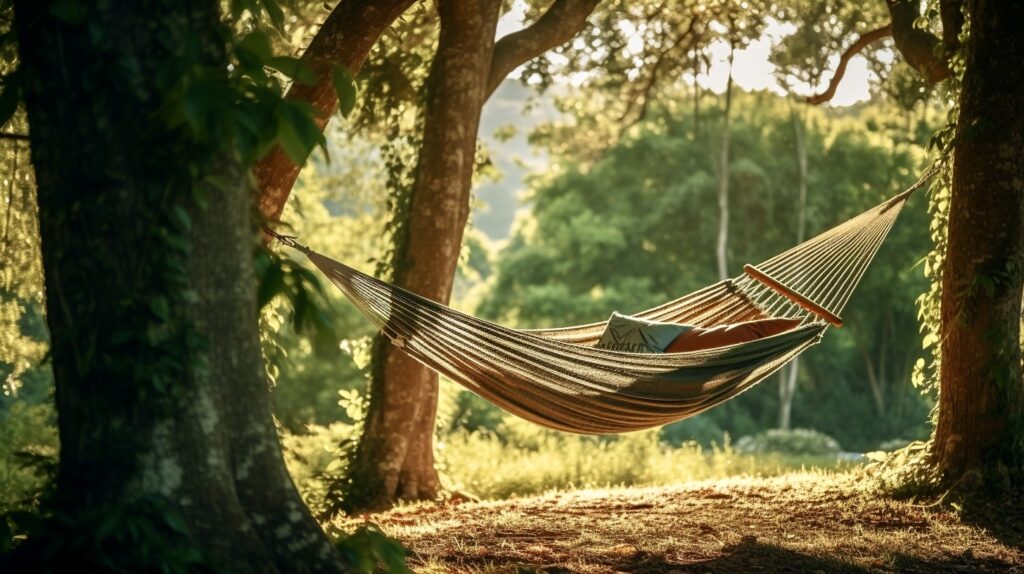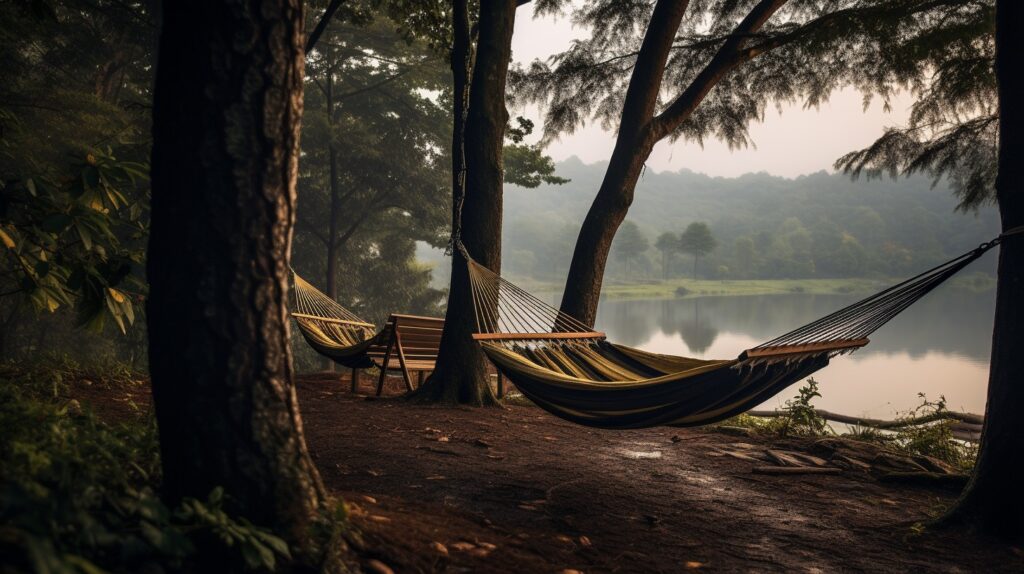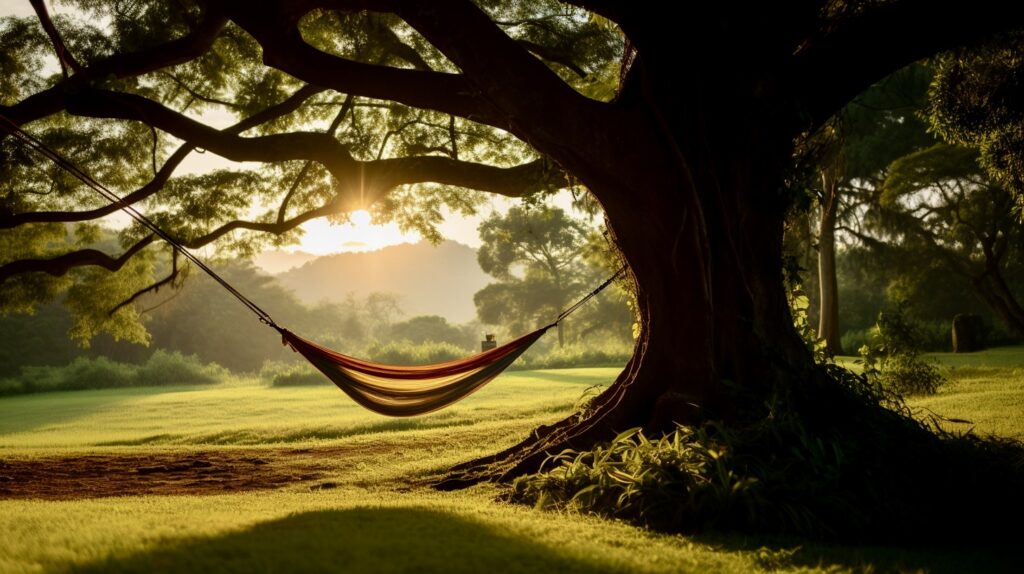Your Oasis in the Wilderness
Hammock camping isn’t just a departure from the ordinary; it’s an invitation to unparalleled comfort. If you’ve ever experienced a night’s sleep on uneven terrain, you know that those roots and rocks have a way of finding their way into your back, leading to a restless, uncomfortable night. But when you’re suspended in a hammock, all of that is no more. The gentle sway of your hammock envelops you in an embrace of relaxation, cradling your body as you drift into a world of dreams.
Say goodbye to that persistent ache in your back, the stiffness in your neck, and those unwelcome morning aches that come from a night of tossing and turning on a rocky forest floor. In a hammock, your body finds its natural alignment, allowing you to wake up feeling refreshed, rejuvenated, and ready for the day’s adventures.
Freedom to Roam
One of the standout features of hammock camping is its unparalleled versatility. Whether you’re deep in the wilderness, next to a pristine lake, or just seeking a brief escape in your own backyard, your hammock is your passport to relaxation. Setting up your hammock easier than you may think – all you need are two sturdy anchor points, such as trees or posts, and you’re ready to elevate your outdoor experience.
The lightweight nature of hammocks makes them a go-to choice for backpackers around the world. Every ounce counts when you’re on the trail, and traditional tents can add significant weight to your pack. With a hammock, you’ll hardly notice the extra load. It’s great for those who want to explore remote and rugged terrains without the burden of cumbersome gear.
Hammocks Leave No Footprint
Hammock camping isn’t just about personal comfort; it’s also a win for the environment. It aligns perfectly with the Leave No Trace principles, which are essential for preserving the delicate ecosystems in the wilderness. When you’re suspended in the air, you’re not trampling on the forest floor, disturbing plant life, or compacting the soil beneath you. Think of those poor bugs!
Traditional tent camping often involves setting up on the ground, which can lead to soil erosion, damage to fragile plant species, and disturbance of small creatures and insects. In contrast, hammock campers leave no footprint. The anchor points of your hammock are generally on sturdy trees or existing supports, so there’s minimal impact on the surrounding environment.
This eco-friendly approach to outdoor camping ensures that the natural world remains undisturbed, allowing future generations of outdoor enthusiasts to enjoy the same pristine landscapes. It’s a responsible way to experience the great outdoors while preserving its beauty and integrity.

Essentials for a Perfect Hang
It all starts with your hammock. Look for one made of high-quality materials and a reliable suspension system. The last thing you want is to find yourself on the ground in the middle of the night due to poor equipment. Make sure that your hammock can safely support your weight and withstand the rigors of the outdoors.
Weather-Ready Protection
The weather can be unpredictable, even in the most serene camping locations. While hammocks offer awesome ventilation and keep you off the damp ground, you’ll still need protection from rain, wind, and the elements. This is where a rainfly or tarp comes into play. It creates a sheltered space over your hammock, keeping you dry and cozy even in the middle of a downpour.
When choosing a rainfly, get for one that offers enough coverage and adjustability, so you can adapt to changing weather conditions.It ensures that your camping experience remains comfortable and dry.
Insulation for Cold Nights
Hammock camping is fantastic, but it can get a little chilly when the temperature drops. To combat the cold, you’ll need insulation. An underquilt is a must-have to keep your backside warm during chilly nights. It hangs beneath your hammock, forming an insulating barrier that traps your body heat.
For added warmth and comfort, invest in a top quilt or a high quality sleeping bag. Snuggle into your chosen insulation layer, and you’ll find yourself cozy and snug, even when the weather takes a turn for the worse. It’s the key to enjoying hammock camping year-round, no matter the temperature.

Tree Hugger Straps
While hammock camping offers the most comfort and convenience, it’s essential to remain mindful of the environment you’re finding yourself in. The beauty of hanging in the trees is that you’re not trampling on the ground, but it’s equally important to ensure you’re not harming the trees you’re suspending your hammock from. This is where tree hugger straps come into play.
Tree straps are designed to distribute the weight of your hammock evenly across a wider area of the tree trunk, minimizing the risk of damage to the bark and branches. They’re not just a practical accessory; they’re a statement of respect for the natural world. By using tree straps, you’ll leave the trees you’ve hung your hammock from not damaged, making sure that future campers can enjoy the same spots.
By hugging the trees, you become an eco-conscious camper, minimizing your impact on the environment and preserving the beauty of the wilderness anywhere you go!
The Little Hammock Luxuries
A pillow or camp pillow is a must for many campers. After all, who doesn’t love resting their head on a soft, plush surface when drifting off to sleep? It’s a small addition that can make a big difference in your overall comfort.
If you’re camping in an area prone to buzzing, crawling, or flying bugs, consider a bug net. It’s protects you against those pesky insects that can interrupt a peaceful night’s rest. With a bug net in place, you can relax without constantly swatting or itching.
Find Your Sweet Spot
Hammock camping might seem straightforward, but there’s an art to getting the perfect hang. It’s all about finding that sweet spot in terms of the hang angle. Too tight, and you’ll find yourself sleeping in a banana shape, which can lead to discomfort. Too slack, and your hammock turns into a flatbed, making it challenging to achieve that ideal, cradled position.
To find the perfect hang angle, experimentation is key. Adjust the suspension straps on both ends of your hammock until you discover the angle that offers you the most comfort and support. It’s a process that becomes more intuitive with experience, but the reward is well worth the effort. A typical hammock is hung between two trees that are 10 to 15 feet apart, so stay within that range for the best results.

